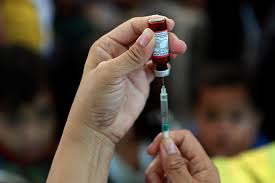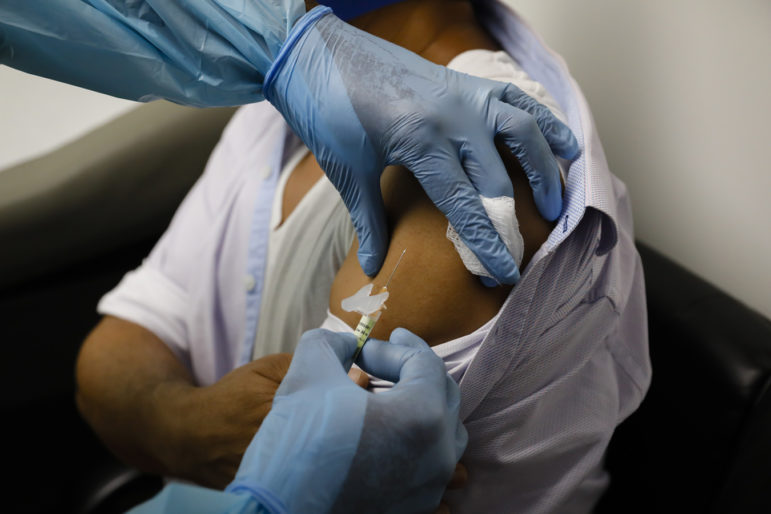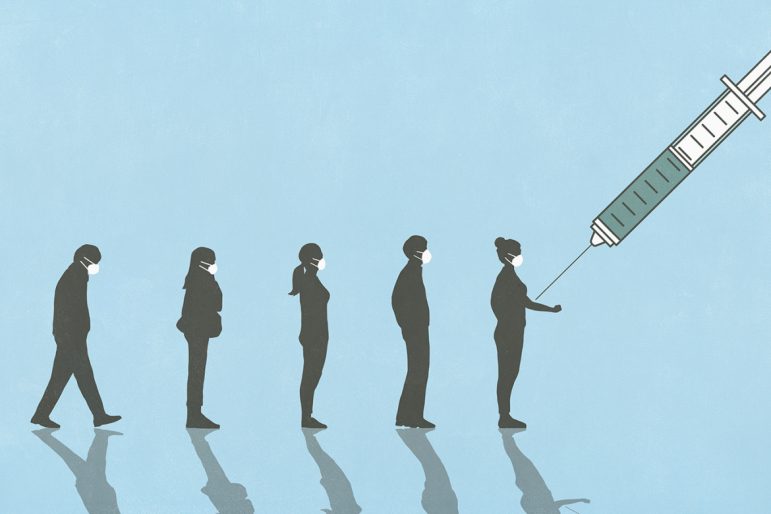After frontline medical workers and residents of long-term care facilities receive vaccines, a consensus is emerging among health experts advising officials in California and nationally that teachers and other school staff be high on the priority list to be vaccinated next.
In an emergency meeting Sunday, an influential advisory panel to the Centers for Disease Control recommended that teachers, school staff and child care workers be among the next group of essential workers to be vaccinated due to the positive impact reopening schools will have on students and their families, and to minimize the health risks to the communities they serve.
The next step is for CDC director Dr. Robert Redfield to approve the recommendations, which he is expected to do shortly.
California is expected to follow suit on Wednesday when the state’s 60-member Community Vaccine Advisory Committee meets to discuss who should get the vaccinations after the first priority group. The committee is chaired by California Surgeon General Dr. Nadine Burke Harris and is made up of representatives from health associations, unions, civil rights organizations and nonprofits.
The 16 member Drafting Guidelines Work Group, a committee of health experts established by Gov. Gavin Newsom to establish priorities for administering the vaccine, has already recommended that 5.9 million workers in the education, emergency services, and food and agriculture sectors should be among the next to get the vaccine.

The workers in these three sectors are about half of the state’s 11.9 million essential workers, according to the advisory committee.
At his briefing on Monday, Newsom said the two committees will meet together to discuss what he said would be the “details and nuances” of “exactly who will be in the next priority category of immunization to get the vaccine.” Newsom encouraged members of the public to join the online meeting, which can be accessed at covid19.ca.gov,
There are 1.4 million people in the California education sector, including child care workers, preschool employees, elementary and secondary school personnel and staff at community colleges, universities and trade schools. The work group is recommending that all members of this sector be given priority for vaccination, while the Centers for Disease Control includes K-12 teachers and child care workers, but not higher education or trade school staff, in its recommendation for priority vaccinations.
Earlier this month leading state legislators sent a letter to Dr. Mark Ghaly, secretary of the California Health and Human Services Agency, asking him to make the vaccination of preschool and K-12 teachers and school staff a top priority, so that campuses can reopen as soon as health officials say it is safe.
“The picture painted by both the public health data and the student progress report data show why it is imperative to prioritize the reopening of our schools within the state’s pandemic response,” stated the letter from Assemblymen Patrick O’Donnell, D-Long Beach, and Jordan Cunningham, R-San Luis Obispo. “Getting our state’s teachers and school staff vaccinated early would allow school district’s to reopen faster and enable our students to return to a workable learning environment.”
O’Donnell, who is chairman of the Assembly Education Committee, also is one of the lead authors of Assembly Bill 10, which would require schools to reopen for in-person instruction in stages in the spring, after state officials have lifted closure orders.
In developing priorities for the first-phase distribution of the vaccine the California Department of Public Health has recommended a phased-in vaccine schedule for health care workers and employees and residents of long-term care facilities. Next, essential workers critical to the state’s daily existence and those at highest risk of becoming infected, severely ill or spreading Covid-19 will be inoculated, according to the department.

Workers in the next phase of vaccinations, like the health care workers in the phase before them, will also be prioritized as to who within those sectors get vaccinations first. Teachers’ union and school district officials, along with others in the public and private sector, have been jockeying to move the people they represent up the list.
The California Teachers Association, the state’s largest teachers’ union, agrees that health care workers should receive the vaccine first, but that teachers and students should also be among the next in line, said Claudia Briggs, spokeswoman for the organization. “Our public schools are vital to California’s full recovery from this pandemic, and we cannot safely and fully return to face-to-face instruction without putting our public-school workers at the top of the priority list,” she said. “We are working with the administration to ensure we get early access, and a guarantee that the distribution of the vaccines will also be done safely, equitably and fairly.”
Many teachers say they are eager to get the vaccine.
Destiny Johnson, a middle school special education teacher at 32nd Street USC Magnet School in Los Angeles, plans to get the Covid-19 vaccine as soon as possible.

“It is important for me to take the vaccine to be safer around my students and colleagues,” she said. “I also have in-laws in their 70s that I would like to see again. I believe it is the responsible thing to do, given there have been so many deaths of the immunocompromised and elderly.”
Anthony Agrella, a teacher at Natomas Middle School in Sacramento, said health workers should have first priority when it comes to vaccination, but that teachers should be in the next group.
Even if teachers move up the priority list, it’s uncertain how many will choose to get the vaccine. But Agrella is confident most teachers will be willing to get the vaccine, saying he’s never met a teacher opposed to vaccinations, although he is sure there are some who are.
“I am absolutely getting the vaccine,” said Agrella, a 55-year-old cancer survivor who describes himself as high risk.
Agrella doesn’t think that vaccinating just the adults in a school provides enough protection. He would like students to be vaccinated before schools reopen as well. “I don’t think it’s safe to reopen schools if kids aren’t vaccinated,” he said. “They have generally been asymptomatic. They could take it home and get their families sick.” Many have older grandparents living with them, putting them at greater risk, he said.
However, if schools were to wait to vaccinate children before reopening campuses they could be closed much longer as clinical trials on children are just beginning. Vaccines aren’t likely to be ready for children until this summer or fall.
Superintendent Fred Van Vleck of Eureka City Schools said the vaccines are needed for teachers as soon as possible so that even if students can’t return this spring schools can offer summer school to give students a chance to make up for learning loss incurred during distance learning.

Eureka City Schools, in Humboldt County in the northernmost part of the state, recently returned to distance learning after being urged to do so by county health officials because of high infection rates in the community. Schools in the district had been using a hybrid model of instruction, which has students rotating on campus part of the week and at home in distance learning the rest of the week.
A survey conducted by the Eureka Teachers Association showed that two-thirds of the district’s teachers are afraid to return to the classroom, Van Vleck said. “Get this vaccine and get it widely distributed. That will solve our problem,” he said.
Another issue that has not been widely discussed is whether school districts can require employees who balk at being vaccinated to do so. Employers can mandate the vaccinations, with some exceptions, according to guidance released Dec. 16 by the federal Equal Employment Opportunity Commission.
Leslie Gielow Jacobs, a professor at the McGeorge School of Law in Sacramento, said employers can set job requirements and even require a medical examination as long as it is job-related. Employers would have to work with employees with disabilities, medical conditions or religious beliefs that preclude them from being vaccinated to find an acceptable alternative work environment. The alternative must be reasonable and not too onerous on the business and could include working from home, if appropriate, she said.
School districts and other employers would have to weigh their legal liability when deciding whether employees should be vaccinated. On one hand, federal labor law requires that employers provide a safe and healthy workplace, which could obligate them to ensure employees are vaccinated, Jacobs said.
But employers also could be liable if an employee has a reaction to a vaccination. “Generally that is what employers are balancing,” she said. “Most are trying to make it voluntary.”
